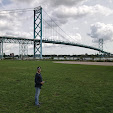The southernmost reaches of the Mississippi River downriver
from greater New Orleans can only be crossed by way of remote &
lightly-trafficked ferries and this service, which connects the communities of
Belle Chasse and Scarsdale in northern Plaquemines Parish, is the northernmost
of the two cross-river ferries in Louisiana’s southernmost parish. Like
its neighboring ferries, this crossing requires the payment of a toll and
ferries depart from each landing every 30 minutes on most days.
A commercial ferry service was established at this location
in 1959. Since 2013, the ferry has been the southernmost crossing of the
Mississippi River open to most commercial vehicles. These vehicles were barred
indefinitely from the downriver Pointe à la
Hache Ferry at the time and this ferry crossing took on somewhat greater
importance as a result. The eastern ferry landing leads to
LA Highway 39, which follows the east bank of the river southward toward Pointe à la Hache and northward toward St.
Bernard Parish and greater New Orleans. LA Highway 3137, known as English Turn
Road – a former alignment of the east bank highway, also begins at the eastern
landing and follows the river for a short distance northward. The western ferry
landing leads to LA Highway 23 (sometimes known as Belle Chasse Highway), which
follows the west bank of the river northward into greater New Orleans and
southward toward Venice and the mouth of the Mississippi River.
This ferry route is located near a popular anchorage point for ocean-going vessels seeking to travel upriver on the Mississippi River through and beyond New Orleans. On any given day, travelers on the ferry will be able to view the line of anchored ships in the river awaiting passage to their destinations inland. This ferry is also located near the so-called “English Turn”, a prominent 120-degree bend in the Mississippi River, named for a chance encounter in 1699 between the initial French explorers to the area and a competing British exploration party. The French party, led by Jean-Baptiste Le Moyne de Bienville, who would go on to establish the permanent settlement of New Orleans in 1718, were successful in convincing the British party to abandon their exploration of the area out of concern that their French rivals had already laid claim to the area.
The following pictures were taken during my eastbound crossing of the Belle Chasse Ferry in January 2018. Included in this set are pictures of English Turn Road (LA Highway 3137). Click on each photo to see a larger version.Dashcam video of the eastbound trip over the Belle Chasse Ferry was filmed in January 2018 for the 'roadwaywiz' YouTube channel and is available for viewing at the link below:
Bridges, Crossings, and Structures of the Lower Mississippi River
Next Crossing upriver: Chalmette-Lower Algiers Ferry (Chalmette, LA)
Next Crossing downriver: Pointe a la Hache Ferry (Pointe a la Hache, LA)
Return to the Bridges of the Lower Mississippi River Home Page
__________________________________________________






















Comments